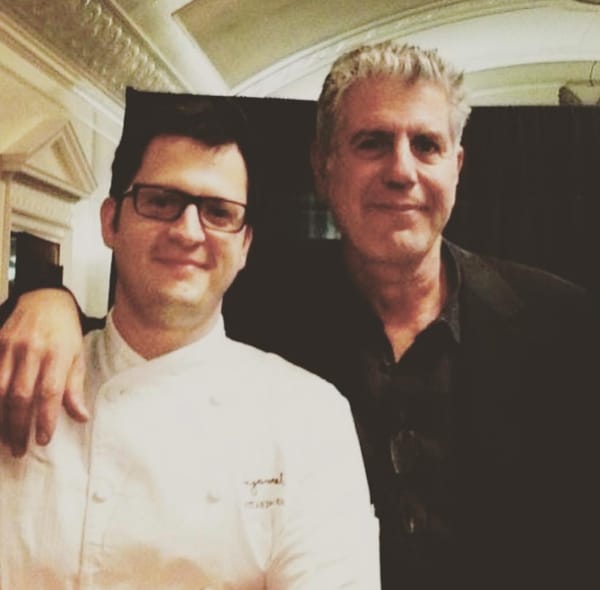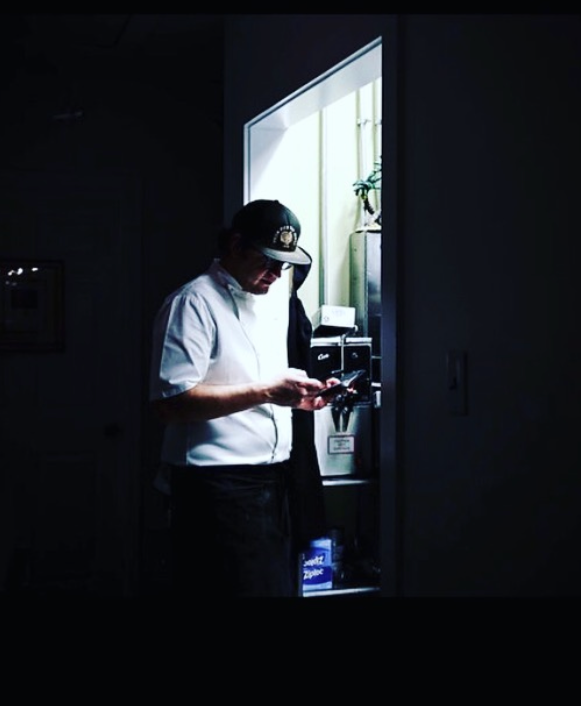Mexico in My Bones, Southwestern Border on My Skin

I’ve been thinking a lot lately about home — not the kind you can find on a map, or the building where you keep all of your shit. Rather, the kind that lives under your skin. The kind that shifts, expands, and sometimes hides from you.
I was born in Chihuahua — cattle country. Desert sun. Wide skies, dry air, the smell of dust and grilled meat everywhere. My first memories of food weren’t fancy or plated – I wouldn’t even know about this well into my 16th birthday, and then for reals well into my 27th. These memories of food were greasy, imperfect, and glorious — burritos stuffed with chiles rellenos, asadero cheese, and frijoles bayos, jalapenos charred just enough, and eaten standing up at the Expogan, that annual carnival-meets-rodeo-cattle auction where the smell of livestock mixed with roasted corn and beer that only northern Mexico border state folks know about. I can still see the cowboys in their pressed jeans, the tejanas, the dusty boots, the corrals, the kids chasing piglets through the dirt. Food wasn’t cuisine, it was a way of being. A language. A heartbeat.
When my family crossed the border into El Paso, that heartbeat changed tempo. Food became survival. Our meals were shorter, simpler, more Americanized. I learned to love bean burritos wrapped in wax paper and beef tacos with yellow cheese and hand-grabbed foods out of a paper bag — and somewhere in that mix of nostalgia and necessity, I found my first lesson in this incessant journey in this country of ubiquitous assimilation: survival means adaptation.
There’s this unspoken rule when you grow up between worlds, that belonging has a price. You learn to soften your accent, hide the things that make people in the new place uncomfortable. You start swapping flavor and authenticity for palatability. You buy the right shoes, listen to the right music, pretend the smell of toasted chiles and masa doesn’t cling to your clothes. You think if you can just blend into the background, you’ll belong. Just stay quiet, don’t make too much noise, and if you don’t move too much they won’t see you. First, survival. Eventually your downfall, if you let it.
I spent years sanding down my edges, thinking I could earn acceptance through performance, through hard work, success, restraint. I learned to “Yes, Chef” my way through rooms that didn’t know how to pronounce my name. I learned how to smile through ignorance disguised as curiosity.
But no matter how much you learn, how well you dress, or how hard you try to sound like you belong, people in these rooms always suss you out. There’s always that moment, a double take, a question about “where you’re really from,” the polite surprise that your food isn’t just tacos. It’s a subtle reminder that you’re welcome, but not quite of the place.
Still, I’ve never been ashamed of what I carry. Mexico lives in my bones, whether I’m cooking for diplomats in DC, wiping down the pass at Amparo, or making a meal for someone I care about at home. I feel it in the way I season, the way I feed, the way I see food as a vessel for memory, impact and change. But the longer I’m here, the more I realize the American Southwestern border and DC live on my skin too; places that taught me ambition, grit, and the complicated art of translation and adaptation. I translate flavors, yes, but also stories of migration, survival, belonging.
There’s a secret I don’t tell food writers or interviewers: I love Taco Bell. Not ironically, not as a punchline. I love it because it’s where the American border really lives. Not in authenticity or purity, but in adaptation. In the absurd, brilliant collision of invention and necessity. I love the audacity of it. The bastardization that became its own culture. I can laugh about it now, but the truth is, that food raised me too. It taught me that flavor is memory, and memory doesn’t have to, or does it ever, ask permission to exist and evolve.
As I’ve gotten older, I’ve tried to cook my way home, to build bridges back to the boy running through the cattle corrals in Chihuahua, the young punk in El Paso washing dishes to help pay rent, the man standing in DC trying to explain why this food, this story, this flavor matters and why it has worth. I’ve spent years trying to understand my place in it all, to find a balance between honoring where I’m from and surviving where I am.
Cooking has always been therapy for me, my way of working through what immigration, assimilation, and ambition have done to me. But it’s also where I find my hardest truths. Because no matter how beautiful the dish, how well-written the story, I can’t save anyone through food. Not my family, not my team, not the community. I can only open the door and hold it wide. The rest: the walking through, the surviving, the healing, that’s on them. Just like it was, and is, on me.
I can teach people technique, leadership, craft; but adaptation, that’s different. That’s something not everyone has, or at least not at the same level. Some people can bend with the pressure, and others break. And in this industry, in this life, if you can’t learn to adapt, you sink. The world doesn’t stop for anyone, and the kitchen sure as hell won’t.
And that’s one of the hardest parts of leadership and being in charge of lives. Watching people you care about and believe in learn the same painful lessons you had to. I can teach them craft. I can give them a stage. But they have to save themselves. I can’t do the work for them, as much as I try or as much as they may want me to. We all have to do it for ourselves if we expect change.
Without friction there is no progress. If you are going through hell, keep going. Pressure makes diamonds, and everyone wants to be a diamond, but very few are willing to be cut.
Some days, this work fills me up. Other days, it hollows me out. Some days I feel like I’m carrying the whole weight of two countries, two identities, two versions of myself: the one who stayed hungry, and the one who finally ate. But even in the exhaustion, there’s gratitude. I get to cook my story. I get to feed people in the language that raised me. I get to do it with people who share these same stories with me.
I am Mexican in the depths of my being. I am American on the surface.And somewhere in between, I’m just a guy trying to make peace with both.
La Ofrenda
Hybrid Recipe: Burrito Norteño Bowl
A love letter to Chihuahua, through the lens of the borderlands and a city kitchen
This isn’t “fusion.” It’s inheritance. It's orgullo. A dish born from cattle country and border ingenuity; humble, bold, unapologetically Northern Mexican. It takes everything I grew up around: charred beef, smoky beans, flour tortillas, and deconstructs it into a bowl that carries the same soul as the burritos I ate at the Expogan as a kid.
Ingredients (serves 4)
- 1½ lbs skirt or flank steak (the closer to overworked muscle, the better)
- 2 tbsp neutral oil or rendered beef fat
- 4 cloves garlic, smashed
- ½ white onion, sliced
- 1 tsp ground cumin
- 1 tsp black pepper
- 1 tbsp salt
- 1 cup pinto beans (cooked from scratch if you have the time)
- 2 cups Mexican red rice
- 1 large roasted poblano, sliced
- 1 avocado, diced
- ¼ cup queso menonita or muenster
- Warm flour tortillas, for serving
- Lime wedges, cilantro, and pickled jalapeños en escabeche
Method
- Char and build flavor. Heat a cast-iron pan until smoking. Add oil, sear steak hard on both sides — you want the crust, the color, the smoke. Don’t move it until it tells you to.
- Sauté and season. Toss in garlic and onion. Let them blister in the beef fat. Add cumin, black pepper, and a bit of salt. Rest the steak, slice against the grain, keep the juices.
- Layer the bowl. Rice on the bottom, beans off to the side, sliced steak over top, roasted poblano, avocado, queso, lime, jalapeños. Drizzle with the steak juices — that’s the good part.
- Serve with tortillas. Tear them, scoop, share. Burritos deconstructed into an act of communion.
Reflection: Food, like identity, doesn’t need to defend its lineage to be real. The flavors of Chihuahua, smoky, direct, wild, live in me whether I’m behind the pass in D.C. or standing in the dirt outside the old family restaurant. This dish isn’t nostalgia. It’s reclamation, proof that the border isn’t a line. It isn't real.




